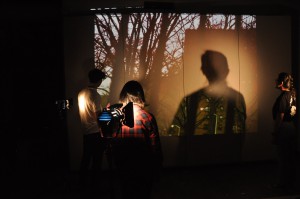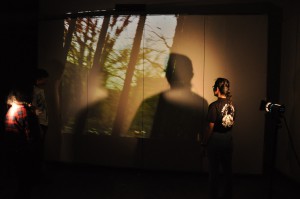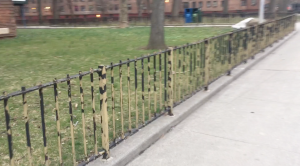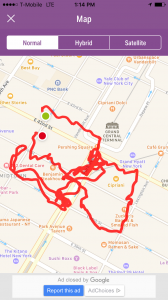The Black Space projects are systems that explore the constraints of darkness.
My project plays on the idea of urban obstruction and access to public spaces. The projected video presents the reality of fenced open areas on the New York City Housing Authority properties. What should be accessible public land utilized by the affordable housing occupants turns out to be a long series of barricades wrapping around the buildings. While the video is projected, three lamps shine on the screen, making it invisible to the observer. The audience has to pass between the screen and the lamps and use their body to obstruct the light in order for the video of the urban barriers to be noticeable.
In this project I continue to draw from my interest in architecture and urban design. The idea was born during lunch at the Office of Urban Design at the NYC Department of City Planning where I currently intern. A few urban planners were complaining about protected open areas in almost all Public Housing and expressed the difficulty of the ongoing conversation to remove the fences. In addition, I have been heavily influenced by my research on psychogeography and especially the book “The City As Interface” by Martijn de Waal.
At the beginning my video was played through Processing and responded to mouse pressing. When the mouse was pressed, the program chose a random place of the video and played it from there. In order to challenge myself in developing a more self-evolving system, I altered the code. Once the mouse was pressed, the program chose a moment of the video based on previous input. First, when the mouse was pressed, it generated a random number from 1 to 5. Then it utilized the frame count at that moment to calculate the new start of the video. For example, when the random number generated was 1, the new start was calculated by subtracting the current frame count from the entire length of the movie and then by subtracting 1. Each number had unique operations attributed to them. That way the system has a degree of autonomy and choice as to what to reveal to its viewers.
Running the project in front of a small audience in an isolated setting during the rehearsal was very successful. People were enjoying blocking the light and observing the video from that “obstructed” perspective. That position definitely focused their attention and allowed them to meditate on the video more than if it was projected regularly. I feel like the project would have been stronger if I had access to brighter lights. When none was covering the lamps you could still see a little bit of the video.
During the show my work was challenging to enjoy. Due to constraints of space I had to constantly switch off my entire setting to allow other students to present their work in total darkness. As a result, my work was often omitted. In addition, there was very little space between the lamp and the video and it was difficult to encourage people to pass by it in a classroom/gallery setting. Moreover, altering the code made the video run very slowly and thus was harder to experience the urgency of the theme.
In the future I would like to experiment with various spatial arrangement of the work as well as variety of obstructing lights. Perhaps adding colorful lights would enhance the experience of the work and make it more appealing to play with. Arranging the work in some sort of wide hallway or on the path to other works would also encourage viewers to engage with the system. Similarly, instead of using the laptop and its trackpad for pressing the mouse, it would be interesting to build a separate visually attractive devise of the same function that would invite the audience to influence the video. Lastly, developing a more successful code that could make the video run faster is recommended.






